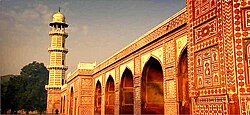Lahore District | |
|---|---|
 Map of Lahore District highlighted within Punjab Province | |
| Coordinates: 31°25′N74°20′E / 31.417°N 74.333°E | |
| Country | |
| Province | |
| Division | Lahore |
| Established | 1849 |
| Founded by | British Raj |
| Headquarters | Lahore |
| Administrative Subdivisions | 05
|
| Government | |
| • Type | District Administration |
| • District Commissioner | Syed Musa Raza |
| • Constituensy (14) | NA-117 Lahore-I to NA-130 Lahore-XIV |
| Area | |
• Total | 1,772 km2 (684 sq mi) |
| Elevation | 217 m (712 ft) |
| Population (2023) [1] | |
• Total | 12,978,661 |
| • Density | 7,324/km2 (18,970/sq mi) |
| Demonym | Lahori |
| Literacy | |
| • Literacy rate |
|
| Time zone | UTC+05:00 (PKT) |
| • Summer (DST) | DST is not observed |
| ZIP Code | |
| NWD (area) code | 042 |
| ISO 3166 code | PK-PB |
| CNIC Code of Lahore District | 3520X-XXXXXXX-X |
| Website | lahore |
Lahore District [a] is a district within the Lahore Division of Punjab, Pakistan, consisting of the provincial capital of Lahore and surrounding areas. It is the most populous district of Pakistan, with a population of 12.9 million in 2023. [1] [3] [4]
Contents
- Administration
- History
- Demography
- Population
- Religion
- Language
- Education
- See also
- References
- External links
The total area is 1,772 square kilometres (684 sq mi). Before 1976, Lahore district was composed of 3 tehsils - Lahore, Kasur and Chunian, but in 1976, Kasur and Chunian tehsils became Kasur District, separate from Lahore District. [5] [6] The remaining area was then sub-divided into 5 tehsils - Lahore, Lahore Cantonment, Model Town, Raiwind and Shalimar.
On 27 August 2024, the Punjab Government announced the creation of five new tehsils - Wagah, Ravi, Nishtar, Iqbal Town and Saddar. Total number of its tehsils now stands at ten. [7] [8]



